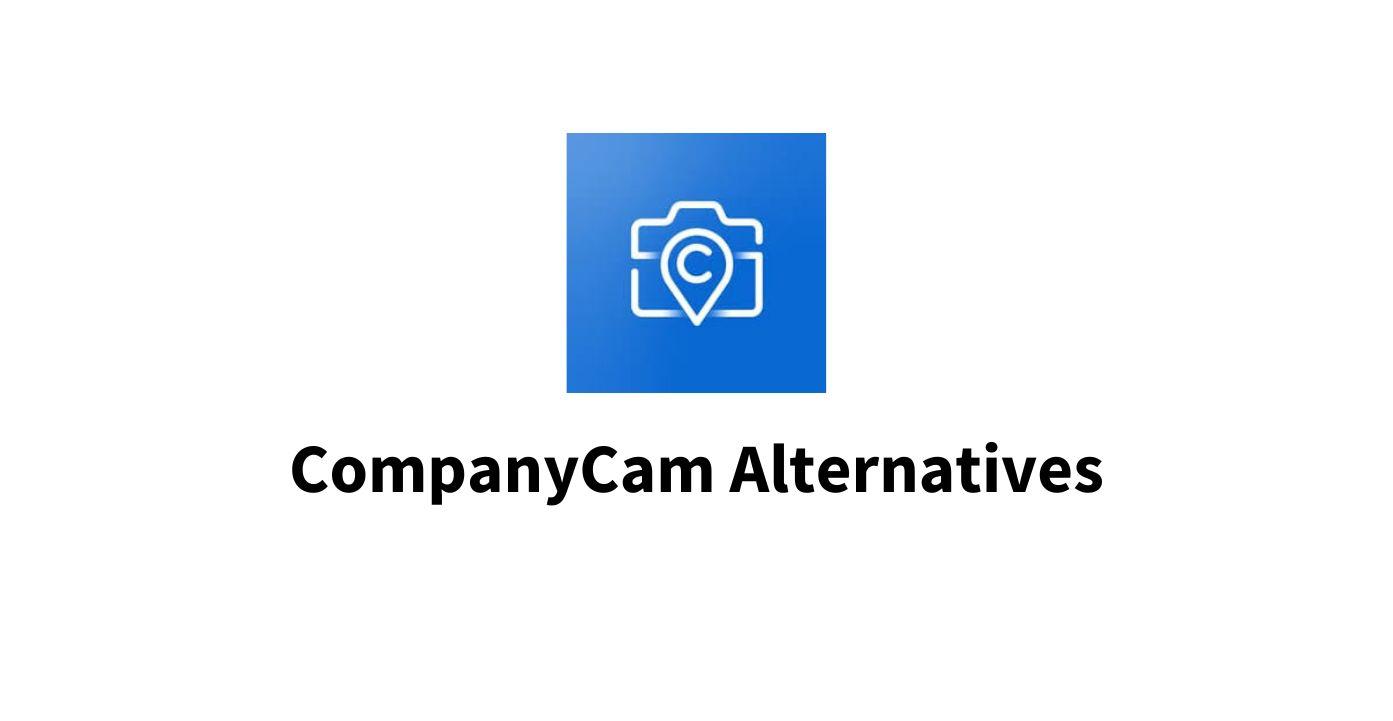JobNimbus Alternatives - The Top JobNimbus Alternatives in 2025
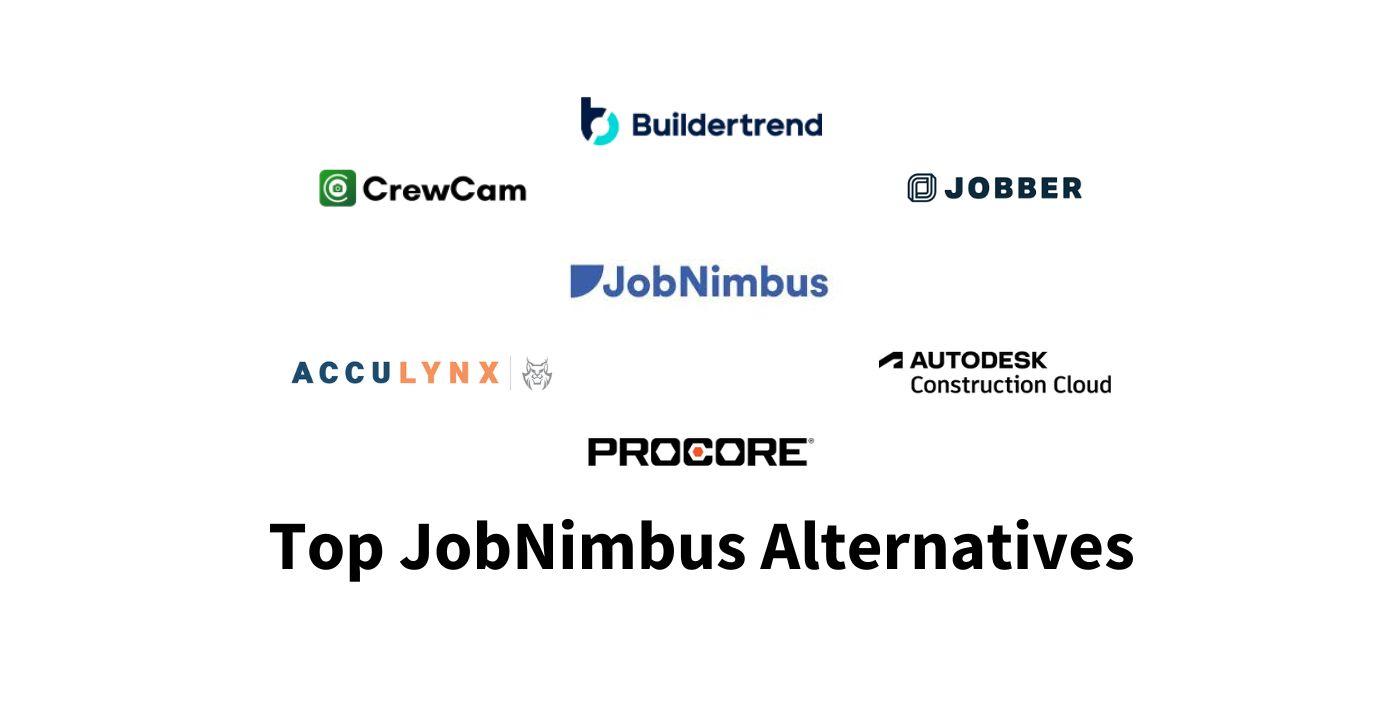
Looking for the best alternatives to JobNimbus in 2025? Here’s a quick rundown:
Managing construction projects effectively requires the right tools. With delays, cost overruns, and poor documentation affecting over 90% of U.S. construction projects, contractors need software that simplifies workflows, improves communication, and reduces risks. Whether you're a small contractor or managing large-scale operations, these platforms offer tailored solutions.
Top JobNimbus Alternatives:
- CrewCam: Ideal for photo documentation with GPS-tagged, time-stamped images, unlimited storage, and annotation tools. Pricing starts at $39/month for 2 users.
- Buildertrend: Comprehensive project management for mid-sized businesses, with scheduling, budgeting, and client portals. Plans begin at $449/month.
- Procore: Best for large enterprises needing full project lifecycle management. Pricing is custom, starting around $4,000 annually.
- AccuLynx: Designed for roofing contractors, offering estimating, photo-sharing, and scheduling tools. Custom pricing available.
- Autodesk Construction Cloud: A unified platform for design-build teams, integrating BIM and project management. Pricing starts at $500/year for basic plans.
- Jobber: Perfect for field service businesses, with scheduling, invoicing, and photo documentation. Plans start at $39/month.
Quick Comparison:
| Platform | Best For | Starting Price | Key Feature |
|---|---|---|---|
| CrewCam | Small teams, photo documentation | $39/month | GPS-tagged, time-stamped photos |
| Buildertrend | Home builders, remodelers | $449/month | Client portals, daily logs |
| Procore | Large enterprises | $4,000/year | Full project lifecycle management |
| AccuLynx | Roofing contractors | Custom pricing | Roofing-specific tools, aerial measurements |
| Autodesk Construction Cloud | Design-build teams | $500/year | BIM integration, document management |
| Jobber | Field service businesses | $39/month | Scheduling, invoicing, mobile-friendly |
Each platform has unique strengths, so the best choice depends on your team's size, project complexity, and budget. Read on for detailed insights on features, pricing, and user feedback.
Jobnimbus vs Acculynx vs Jobber – Pick The BEST Option For Contractors in 2025! (FULL OVERVIEW!)
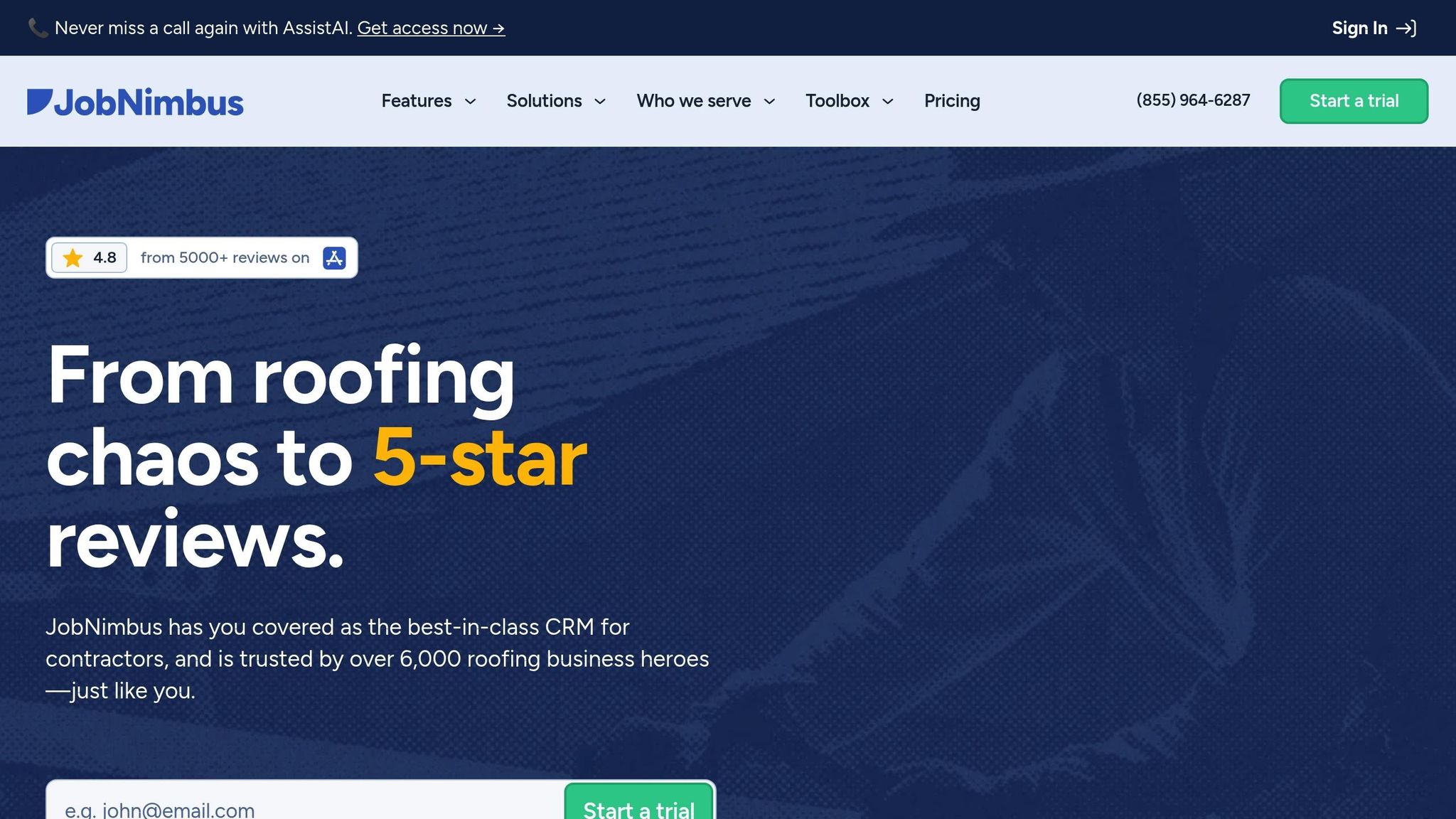
1. CrewCam

CrewCam is a visual photo documentation tool tailored for contractors who need dependable records of their jobsites. It uses automatic GPS and time stamps to ensure accurate documentation, which helps with liability protection and smooth project communication. This solid foundation supports a range of features designed to boost clarity and accountability on projects.
One of CrewCam’s key features is unlimited photo and video storage, offering a reliable way to document jobsite conditions. This feature is particularly helpful for resolving insurance claims, handling customer disputes, or maintaining quality control.
The platform goes beyond storage with its annotation tools, which let users enhance photos with drawings, arrows, text, and voice notes. These tools make it easy to communicate details without lengthy explanations. Additionally, photo tagging and filtering features allow users to quickly find specific images across multiple projects.
Collaboration is another strong suit. CrewCam enables team members to upload photos to shared projects, keeping everyone in the loop through a live project feed. Managers can control access by setting permissions for who can view or edit content. For better workflow management, the app includes project-based and photo checklists, along with customizable templates for recurring tasks.
"CrewCam is a MUST" - Anthony H., Construction
The platform’s AI-powered reporting tools simplify admin tasks by generating shareable project summaries, saving time and effort. It also includes document management features, such as the ability to scan, upload, and collect digital signatures directly within the app..
Pricing starts at $39/month for 2 users, $89/month for 5 users, and $224/month for 15 users, with enterprise options available upon request. CrewCam offers clear value by improving documentation and team communication.
2. Buildertrend
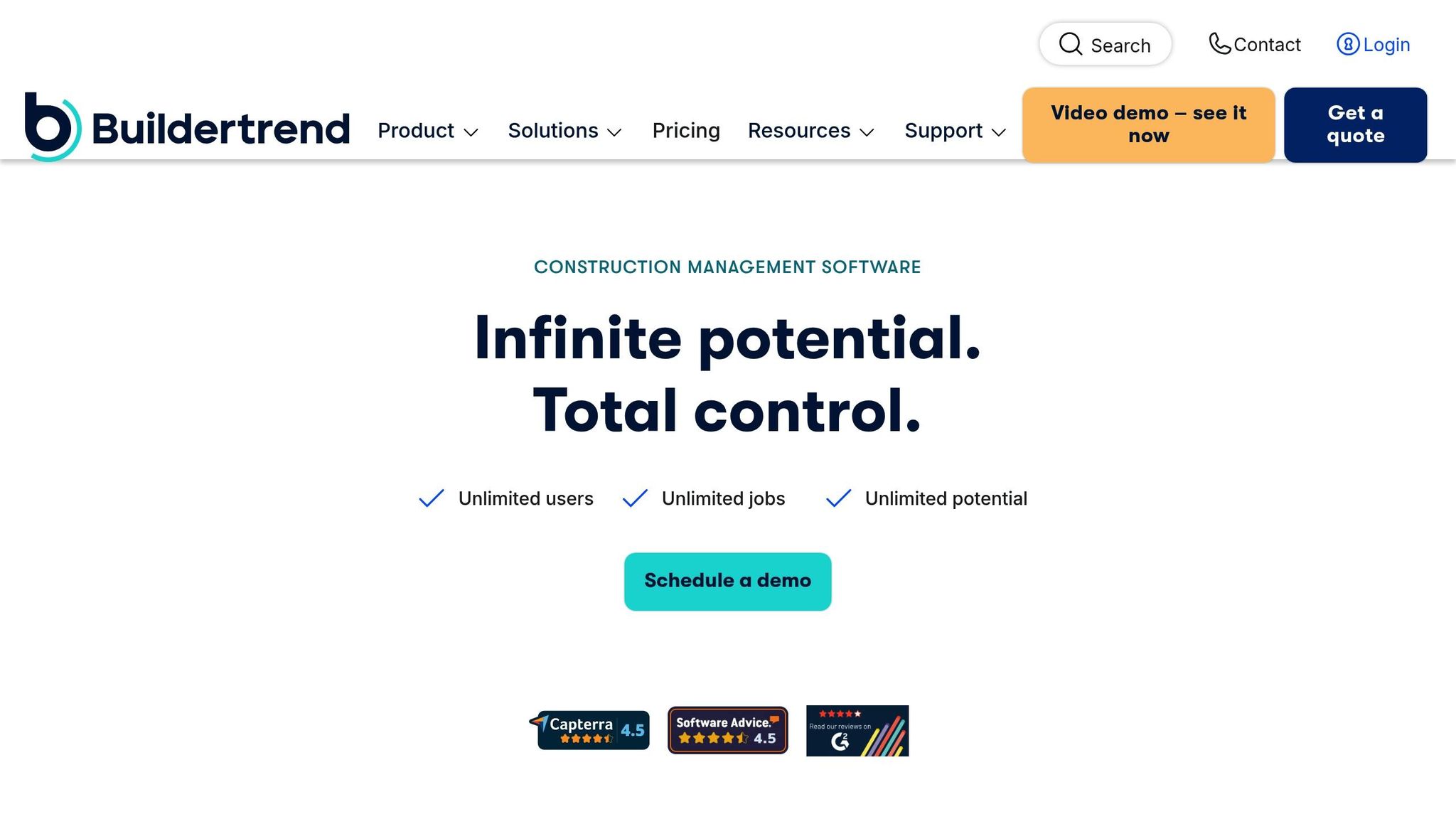
Buildertrend stands out as a comprehensive construction management platform, combining tools for scheduling, budgeting, client communication, and photo documentation. Designed with mid-sized to large businesses in mind, it addresses common challenges like project delays and documentation gaps.
The platform’s mobile app makes real-time jobsite updates a breeze. Users can upload photos, documents, and videos directly into the project workflow, ensuring seamless tracking of progress, hours, and punch-list items. Its daily log function further enhances documentation by capturing details like on-site personnel, weather conditions, and commentary. These logs are instantly shareable with subcontractors and clients.
"The daily log function on Buildertrend has been a huge asset for us because not only are we uploading photos, we're also able to add commentary, track who is on site, weather conditions, and one of the great features is that we're able to share it with subcontractors AND our clients. So, no matter who's viewing it, we can all have visibility of what happened that day and we are all on the same page."
- Nick Schiffer, Founder & Owner of NS Builders
Buildertrend also simplifies client communication through its client portal, which automates weekly updates. These updates summarize project progress and upcoming tasks, keeping clients informed without requiring constant manual effort. The change order tracking feature allows managers to document changes on-site using photos and collect client signatures directly on mobile devices, speeding up payment processes.
"One of the first ah-ha moments for me on Buildertrend was the change order feature. This has absolutely revolutionised what we do when it comes to change orders. Now all of our field project managers can pull out their iPad or their phone, they can talk about the change order right there, they can document it, and the client can even sign it in the field, which means that we're having expectation conversations earlier in the process and that means that at the end of the job, we actually get paid."
- Matt Risinger, CEO of Risinger Build
Pricing and Plans
Buildertrend’s pricing is tailored to company size, annual construction volume, and operational needs. Most customers spend between $8,000 and $10,000 per year for full access with unlimited users under a single company license. For 2025, the subscription tiers include:
- Essential Plan: $449/month (billed annually)
- Advanced Plan: $719/month
- Complete Plan: $989/month
User Feedback
Buildertrend earns consistently high marks from users, with ratings of 4.5/5 on Capterra, 4.2/5 on G2, and 4.6/5 on GetApp. Around 85% of reviewers give it 4 or 5 stars, praising its ease of use, custom reporting, collaboration tools, and responsive customer support.
Considerations
While Buildertrend is a powerful tool, it’s best suited for businesses with an annual construction volume of at least $500,000. Smaller operations may find the platform overwhelming. Some users have reported occasional slowness and a learning curve for advanced features. Additionally, the absence of a free trial can make it harder to evaluate the platform before committing to an annual subscription.
3. Procore
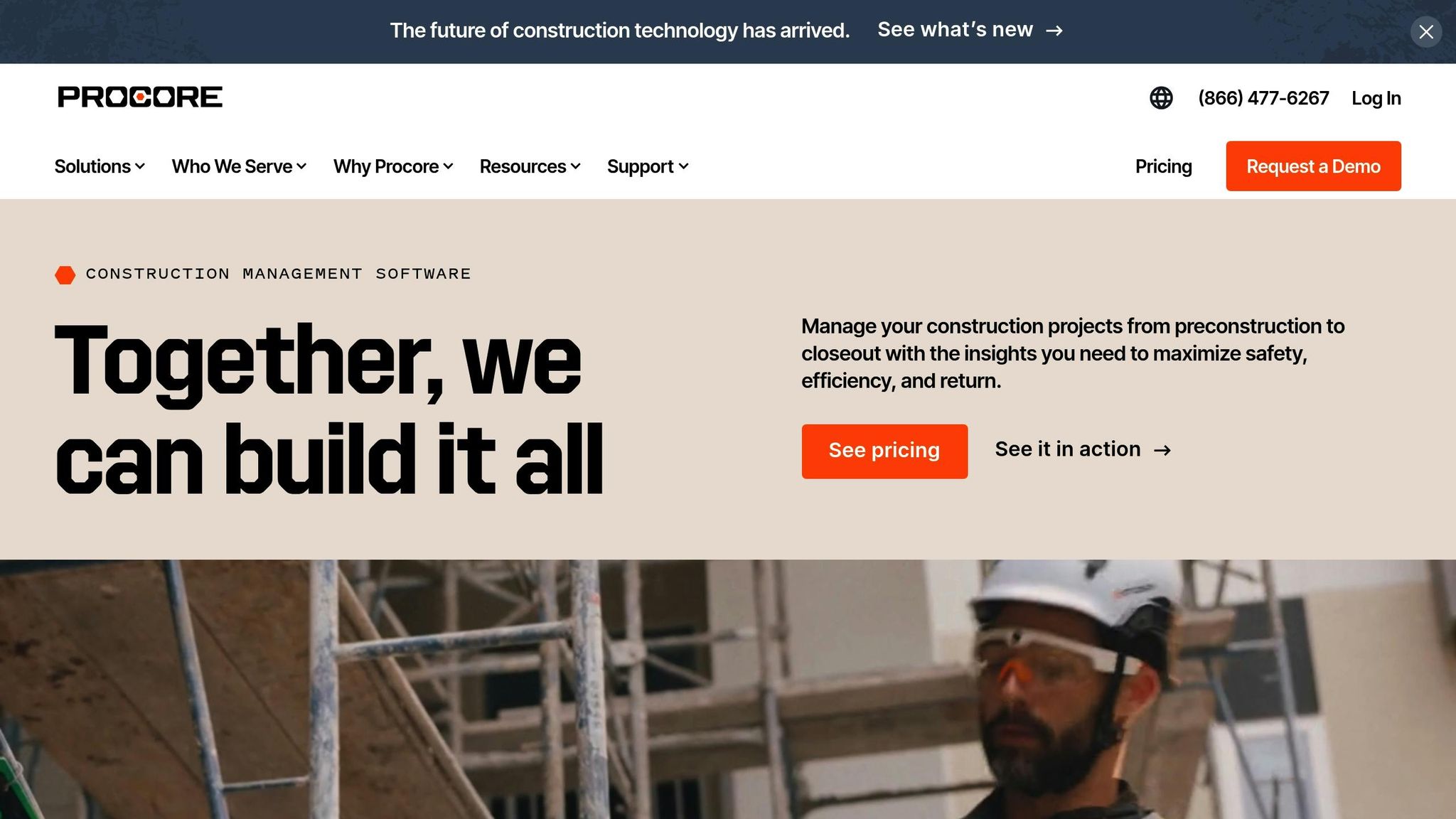
Procore is a construction management platform designed for large-scale projects, serving more than 3 million projects across 150+ countries. It caters primarily to larger contractors and construction companies, offering tools that cover the entire project lifecycle - from preconstruction planning to final closeout. A key feature that sets Procore apart is its robust photo documentation system.
Photo Documentation Features
Procore's photo documentation tools are a standout, offering unlimited cloud storage and advanced organizational features. Users can securely capture, store, and share project photos in an online archive, with customizable permission settings to control access across teams. Uploading photos is seamless, whether through drag-and-drop functionality, upload buttons, or project-specific email addresses.
A unique location-based photo linking system connects images directly to project drawings, making it easier to track and manage visual data. The Procore Maps feature adds another layer, allowing users to view photos on an interactive map and filter them based on geographic location. Field teams can annotate photos with comments and details directly from their mobile devices, creating a comprehensive visual record of ongoing work.
"Procore's collaborative platform is where we can take all data and draw in project and portfolio-level analytics. It's an easy, centralized source of truth that helps us make decisions with integrity." - Abhilash Kunnatoor Margabandu, Director, Solutions Architecture and Engineering, Vantage Data Centers
Procore supports common image formats and organizes photos into albums linked to daily logs. Users can also mark images as private when necessary. However, larger image files (over 5MB) may require resizing to avoid upload issues. Additionally, Procore integrates with over 500 third-party applications through its App Marketplace, significantly expanding its capabilities.
Pricing and Enterprise Focus
Procore uses a custom pricing model based on annual construction volume (ACV), rather than charging per user. This model includes unlimited users, data storage, and 24/7 support under a single annual contract. Pricing estimates depend on company size:
- Small contractors: $4,000–$6,000 annually
- Mid-sized companies: $10,000–$15,000 annually
- Large enterprises: $20,000+ annually with tailored features
Vendr reports that Procore contracts typically range from $14,940 to $257,549 per year, with a median cost of $76,065. Procore justifies its pricing by aligning costs with the value provided through improved efficiency, cost savings, and productivity.
"The more projects you run through Procore, the more value you receive from the software in terms of cost savings, efficiencies, and productivity gains." - Procore
User Experience and Performance
Procore is well-rated across various review platforms, earning 4.5/5 on Capterra, 4.6/5 on G2, and 4.5/5 on Software Advice. With over 2 million users and a reported 90% customer satisfaction rate, the platform is widely praised for its comprehensive project management tools and reliable document storage system.
That said, Procore isn't without challenges. Many users note its steep learning curve, particularly for those new to construction management software. Training is often required to navigate its complex interface. Performance issues, such as slow uploads for large files or delays with intricate project data, have also been reported. Additionally, the annual pricing model, while predictable, can strain the budgets of smaller contractors, especially with regular price increases.
Strategic Considerations
For contractors handling large projects and needing thorough documentation, Procore offers a powerful solution. To ensure smooth adoption, it’s essential to establish internal implementation teams and take advantage of Procore’s extensive training resources. The platform’s AI-powered tools, like Procore Helix, are also evolving to simplify repetitive tasks, such as drafting RFIs and setting up projects, making it a forward-looking choice for the construction industry.
However, for smaller companies or those prioritizing simplicity, Procore’s enterprise-level features and associated costs may be excessive. It’s most effective when high construction volume and team collaboration needs justify the investment. In the next section, we’ll explore other solutions that cater to a wider range of contractor requirements.
4. AccuLynx
AccuLynx is a cloud-based CRM and project management tool specifically designed for roofing contractors. It combines features like estimating, photo-sharing, aerial measurements, material ordering, and labor scheduling into one platform. Roofing companies of all sizes across the United States rely on it to streamline their operations.
Photo Documentation and Project Management Features
AccuLynx integrates photo-sharing with project management, making it easy for teams to document each stage of a project. Photos from Hover sync directly to job folders, while the Story View feature keeps job communications organized into clear threads. This allows users to quickly review updates, track conversations, and pinpoint potential delays.
The mobile Field App offers even more flexibility. Users can create customizable proposals, digital packets, and personalized pages, all while accessing Story View in real time. A drag-and-drop calendar simplifies scheduling, and automated notifications ensure everyone stays informed of any changes.
"AccuLynx allows project teams to collaborate in realtime and service customers without making unnecessary trips into the office or meeting with homeowners in person." - Mike Stein, Chief Executive Officer of AccuLynx
Performance Impact and User Benefits
AccuLynx has proven to boost efficiency and profitability. Contractors report saving an average of 9 hours per week, while users have seen job profits increase by 32% on average within the first year of use. These gains come from consolidating multiple tools into one streamlined platform.
"AccuLynx has not only helped us save time, but it has also allowed us to eliminate many of the other software programs we were using. With AccuLynx, we are spending less money on technology per employee than before." - Joe Boyd, Owner, Complete Exteriors
Integration Ecosystem
AccuLynx connects seamlessly with tools and services tailored for U.S. construction professionals. It integrates with major material suppliers like ABC Supply, QXO (formerly Beacon Building Products), and SRS Distribution, offering real-time access to product catalogs with company-specific pricing and enabling direct material orders.
In addition, it works with measurement tools such as EagleView and lead generation platforms like HubSpot, Hatch, and Angi. Accounting integrations include QuickBooks and Sage Intacct, while CompanyCam ensures photos and documents sync directly to job files. A Zapier connection further expands compatibility with thousands of business apps.
Pricing Structure and Market Position
AccuLynx uses a custom pricing model with two plans: Pro and Elite. Pricing depends on the number of users and selected features, and monthly subscriptions are available without long-term contracts. While many users praise the platform, its cost-effectiveness has sparked mixed reviews.
Software Advice rates AccuLynx 4.5/5, GetApp gives it 4.6/5, and its value-for-money score stands at 4.2/5. However, smaller businesses sometimes struggle with the pricing:
"We were hesitant at first because this was a big jump in price from what we were using before. BUT, it has exceeded expectation and we are super happy with the system and the customer service provided." - Julia C, Vice President - Operations
On the flip side, some users find the cost difficult to justify:
"The cost is now more than the benefit from the software. It is just too expensive especially for a small business with only 2-3 users." - Sheena P, Owner/Operator
Strategic Considerations for Contractors
AccuLynx's roofing-specific features make it a strong choice for contractors in this niche, offering tools that more general construction platforms may lack. Its focus on remote collaboration - enhanced by updates introduced in November 2024 - aligns with the growing demand for flexible work solutions in the construction industry. That said, contractors should carefully weigh their needs and budgets before committing. Up next, we’ll explore another option to broaden your project management toolkit.
sbb-itb-5f4c686
5. Autodesk Construction Cloud
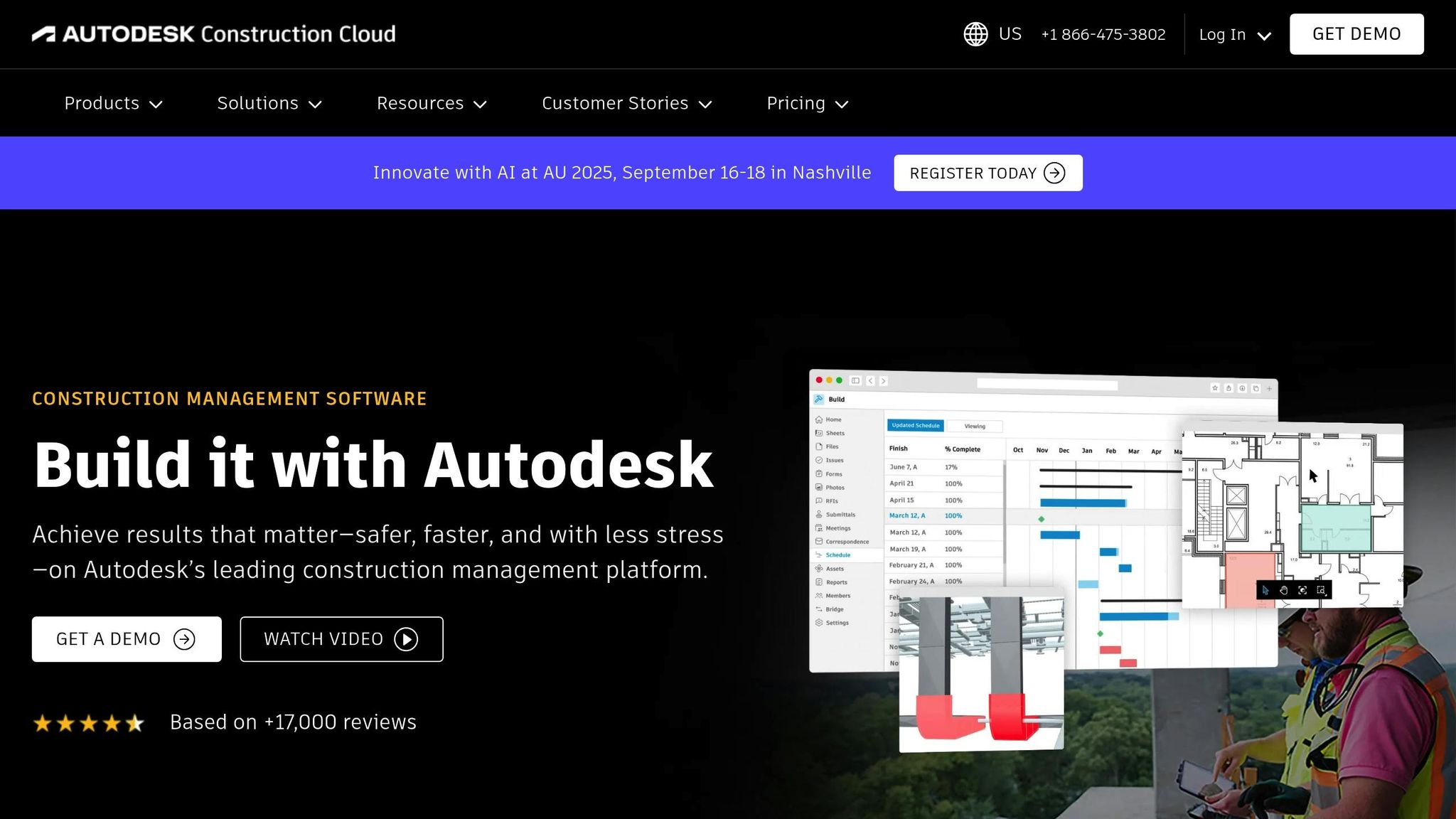
Autodesk Construction Cloud (ACC) offers a unified platform for construction management, bridging the gap between field and office teams with tools for RFIs, submittals, and daily reports. Trusted by builders on more than 2 million projects, ACC serves as a centralized hub for managing every aspect of construction projects.
Photo Documentation and Project Management Features
The Photos tool within Autodesk Build is a standout feature of ACC, designed to streamline visual documentation for project teams. It handles progress photos, material tracking, quick updates, and visual references for issues and RFIs. Teams can manage both standard and 360° photos and videos through web or mobile platforms, enabling real-time documentation directly from the job site. The mobile app further enhances usability with advanced search options, filtering capabilities, and a built-in 3D model viewer for better data visualization.
Administrative Control and Workflow Management
ACC gives project administrators precise control over the Photos tool, allowing them to enable or disable it for specific projects or across multiple projects as needed. Its centralized document management system ensures that all project-related documentation - from design to operations - is well-organized, reducing miscommunication and streamlining workflows.
Integration Ecosystem and Connectivity
One of ACC’s strengths lies in its broad integration capabilities. With over 400 pre-built connections to ERPs, CRMs, document management systems, and analytics tools, it supports seamless data flow across platforms. ACC Connect, its no-code/low-code integration solution, allows users to create custom connections with third-party applications and databases. Recent updates have further simplified workflows, enabling features like content migration, document overlay, change order exports, and schedule synchronization.
Pricing Structure and Options
ACC operates on a subscription basis, offering four pricing tiers to meet varying project and team needs. These include:
- Autodesk Docs: $500 per year
- BIM Collaborate: $705 per year
- Autodesk Takeoff: $1,250 per year
- Autodesk Build: $1,625 per year
Users can choose between named-user and multi-user licenses, with costs depending on subscription length, the number of users, selected modules, and renewal terms. Bundling multiple ACC modules can lead to cost savings, and additional discounts are available for volume licensing, multi-year commitments, and industry-specific programs. A 30-day free trial is also offered, along with purchasing options through authorized resellers who provide local support, implementation help, and custom training.
Strategic Considerations for U.S. Construction Teams
ACC’s extensive features - ranging from detailed photo documentation to seamless integration capabilities and flexible pricing - make it a strong choice for large-scale projects. By unifying design and construction workflows into a single source of truth, ACC helps U.S. construction teams improve collaboration, reduce inefficiencies, and achieve better project outcomes. Its adaptability to diverse project demands ensures it remains a valuable tool for teams aiming to enhance productivity and coordination.
6. Jobber
Jobber is a service management platform designed specifically for field service businesses like contractors, landscapers, and home service professionals. With high ratings across platforms - 4.5/5 stars on Capterra, G2, and Software Advice, and an impressive 4.8/5 on the iOS App Store - it’s a trusted choice for U.S. contractors looking to simplify their operations.
Photo Documentation and Visual Project Management
Jobber allows field teams to document work visually by capturing before-and-after photos through its mobile app. These photos can be attached to invoices and quotes, providing clients with clear visual updates in their profiles. Additionally, Jobber integrates with CompanyCam, making it easy to share jobsite images with customers directly through jobs and invoices [63, 64, 65]. This visual documentation helps improve communication and keeps workflows running smoothly.
Operational Efficiency and Time Savings
Jobber helps service professionals save over 12 hours each week and increases first-year revenue by 44%. One contractor from Montreal shared their experience:
"With Jobber, everything was in one place - scheduling, invoicing, estimates, and request systems. We couldn't find any other app with all of those things in one place."
Its mobile-first design is particularly beneficial for field teams. A representative from MITHGO Outdoor Services said:
"Jobber has taken a lot of stress off my shoulders. I can invoice from my cell phone. I'm not tied to my office."
Integration Ecosystem and Workflow Automation
Jobber’s open API and Zapier integration connect it to over 2,000 third-party apps, making it a versatile tool for contractors. Popular integrations include QuickBooks Online for accounting and Mailchimp for customer communications. These features help automate lead management and centralize customer data, saving businesses approximately 7 hours per week on administrative tasks [69, 70].
Pricing Structure and Value
Jobber offers flexible pricing to fit businesses of various sizes, operating on a per-user model with four tiers. Here’s an overview of its pricing plans:
| Plan | Monthly Billing | Annual Billing | User Limit | Additional Users |
|---|---|---|---|---|
| Core | $39/month | $29/month | 1 user | $29/user/month |
| Connect | $169/month | $129/month | Up to 5 users | $29/user/month |
| Grow | $349/month | $249/month | Up to 10 users | $29/user/month |
| Plus | $599/month | $449/month | Up to 15 users | $29/user/month |
The Core plan works well for solo contractors, while the Connect and Grow plans cater to expanding teams. The Plus plan is suited for larger operations that need advanced tools. For payment processing, Jobber Payments charges 2.9% + 30¢ per credit card transaction and 1% for ACH/bank payments.
Strategic Considerations for U.S. Contractors
Jobber stands out by focusing on field service businesses and offering straightforward pricing. It’s tailored for contractors in the U.S. and Canada, with pricing that works well for smaller teams but may become costly for larger ones. For professionals who value integrated photo documentation and efficient service management, Jobber provides a practical and user-friendly solution.
Pros and Cons Comparison
Choosing the right construction management platform means evaluating each tool's strengths and challenges. Here's a detailed comparison of six popular options based on key factors that matter to contractors and service professionals.
Feature-by-Feature Analysis
Photo Documentation and Visual Management
CrewCam stands out with its GPS-tagged photo documentation, time stamps, unlimited storage, and annotation tools. Buildertrend offers solid photo features integrated with client communication capabilities. Procore provides a more comprehensive document management system but comes with a steeper learning curve. AccuLynx caters specifically to roofing contractors, while Autodesk Construction Cloud combines design files and collaboration tools into one workspace. Jobber, on the other hand, focuses on simplicity with its intuitive service management interface.
While features are essential, ease of use and system integrations also play a significant role in decision-making.
User Experience and Learning Curve
Ease of use and training requirements can make or break the adoption of a platform. Buildertrend is highly rated for its user-friendly design, especially for residential contractors. Jobber also receives strong feedback for its straightforward approach to service management. However, Procore, used by over 2 million construction professionals globally, offers a robust feature set that often requires additional training and onboarding to fully utilize.
Integration Capabilities
Integration options vary widely across platforms. Procore supports numerous third-party integrations, though some users report occasional compatibility issues. Autodesk Construction Cloud is particularly valuable for teams already using tools like Revit and BIM 360. However, it may face performance issues when handling very large BIM models.
These integration capabilities lead naturally into considerations of pricing and overall value.
Pricing and Value
The pricing structures of these platforms reflect their different target audiences:
| Platform | Starting Price | Best For | Limitation |
|---|---|---|---|
| CrewCam | $39/month | Small teams needing photo documentation | Limited to 2 members on the basic plan |
| Buildertrend | $99/month | Home builders and remodelers | Limited customization for complex projects |
| Procore | $375/month | Enterprise-level contractors | High cost unsuitable for smaller firms |
| Jobber | $39/month (Core) | Field service businesses | Costs increase significantly as team size grows |
| AccuLynx | Custom pricing | Roofing contractors | Lack of pricing transparency |
| Autodesk Construction Cloud | Custom pricing | Design-build teams using BIM | Complex and unclear pricing structure |
Cost Efficiency
CrewCam and Jobber both start at $39/month, but they serve different needs - CrewCam focuses on visual documentation, while Jobber offers broader service management. Buildertrend, Procore, and Autodesk Construction Cloud cater to larger operations, with Procore offering a premium suite of features at a higher cost.
Industry-Specific Strengths and Weaknesses
Procore is a powerhouse for workflow automation, document management, and change order processing, making it ideal for large-scale, multi-site projects. Autodesk Construction Cloud excels in integrating design and construction workflows, which is a big advantage for teams using BIM technologies, though it may struggle with very large models. Buildertrend shines in client communication, making it a top choice for residential and remodeling projects, despite its limited customization for complex needs.
For contractors looking for specialized solutions, these strengths and limitations help narrow down the best fit for their projects. Surveys show that 91% of users prioritize project management features, and 83% value document management. This highlights why tools like CrewCam, with its focus on visual documentation, and Procore, with its extensive project management capabilities, remain in high demand. Each serves a unique segment of the construction industry, helping professionals find the right tool for their specific needs.
Conclusion
When selecting a platform, it's essential to match it to your business size, project complexity, and specific needs. The alternatives to JobNimbus in 2025 cater to various contractor types and project requirements, offering tailored advantages.
For small to medium-sized businesses, CrewCam stands out with its GPS-tagged photo documentation and unlimited cloud storage. Its focus on real-time photo management helps contractors capture and organize crucial project details. On the other hand, Buildertrend is an excellent choice for home builders and remodelers who value seamless client communication alongside project management.
Larger enterprises may find Procore appealing for its robust workflow automation and document management capabilities. Similarly, Autodesk Construction Cloud is ideal for design-build teams, thanks to its strong BIM integration and compatibility with other Autodesk tools.
For service-oriented businesses, Jobber offers an intuitive service management platform, while AccuLynx remains a go-to for roofing contractors, thanks to its specialized features. When making a decision, consider factors like mobile accessibility and integration options to ensure smooth collaboration across your team.
If your business involves managing multiple subcontractors across different locations, prioritize tools with advanced scheduling and communication features. On the other hand, contractors who rely heavily on visual documentation may benefit more from solutions like CrewCam.
Look for platforms with user-friendly mobile access and open APIs to avoid data silos and streamline workflows. With 63% of buyers preferring integrated software suites over standalone tools, choosing a solution that supports your current operations while offering reliable updates and support is crucial.
As the construction software market grows at an annual rate of 12.6%, investing in forward-thinking technology is more important than ever. The right platform can help address communication breakdowns - an issue impacting 59% of construction owners - and improve overall project efficiency. By aligning your software choice with your operational needs, you set the stage for more effective project management and long-term success.
FAQs
What should I look for in a JobNimbus alternative for my construction business?
When considering alternatives to JobNimbus for your construction business in 2025, look for tools that provide flexible project scheduling, real-time updates, and efficient document management. These features can help keep your workflows smooth and your jobsite records well-organized.
It's also important to choose software that grows with your business, integrates smoothly with the tools you already use, and is easy for your team to navigate. Mobile access is a must, letting your team stay productive from anywhere, while strong data protection ensures sensitive information stays secure. Platforms offering AI-driven automation and reliable mobile functionality can further boost efficiency and help keep your projects on track.
What are the pricing options for JobNimbus alternatives, and how can I budget based on my company's size?
Pricing for Construction Management Software Alternatives to JobNimbus in 2025
The cost of construction management software in 2025 will depend heavily on your business size and the specific features you need. For smaller businesses, basic plans usually start at about $280 per month, while larger organizations may spend upwards of $1,200 per month for more advanced options.
If the software uses per-user pricing, the monthly cost typically falls between $30 and $300 per user, depending on the platform's capabilities. Here's a general breakdown:
- Small businesses: Plan to spend between $300 and $600 per month.
- Medium-sized companies: Costs may range from $1,000 to $2,000 per month.
- Large enterprises: Expenses can be much higher, depending on the number of users and the need for advanced features.
When choosing the right solution, think about your team size, the features you'll need, and how well the software can grow with your business. This will help you find an option that fits both your needs and your budget.
What are the main advantages of using platforms like Procore or Autodesk Construction Cloud for managing large construction projects?
Platforms like Procore and Autodesk Construction Cloud bring powerful solutions to the table for managing large construction projects. These tools help simplify complex processes, improve efficiency, and keep everything running smoothly. By focusing on collaboration, real-time data sharing, and streamlined workflows, they ensure teams stay connected and on track.
Procore excels in project management by enhancing communication, improving document organization, and providing tools for financial tracking. This combination helps minimize risks and keeps productivity high. On the other hand, Autodesk Construction Cloud bridges the gap between design, construction, and operations. It boosts project visibility, automates repetitive tasks, and reduces errors, giving teams the insights they need to make smart decisions. Both platforms are designed to help teams handle intricate tasks, meet deadlines, and stick to budgets with confidence.
Related Blog Posts
See CrewCam in action


%20(3).svg)


